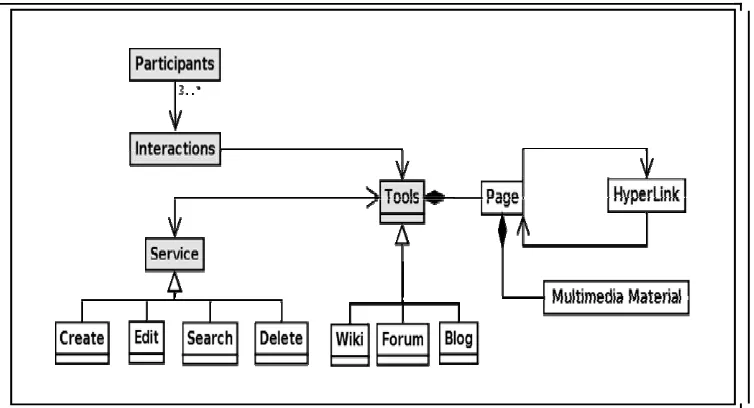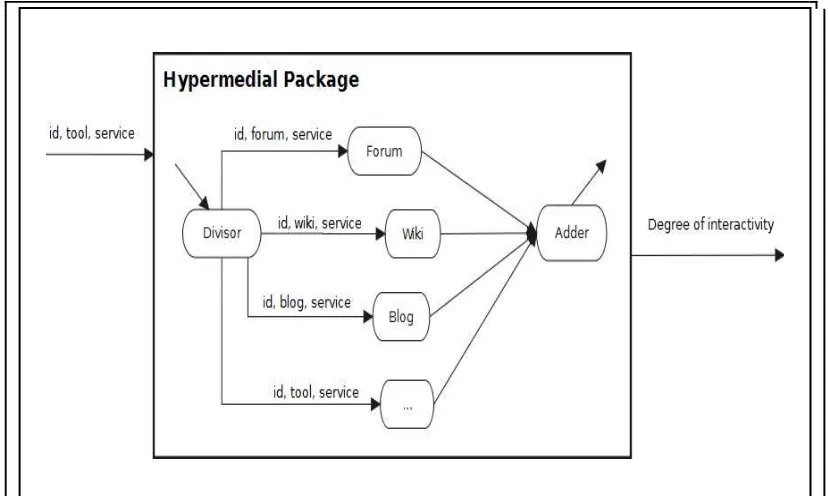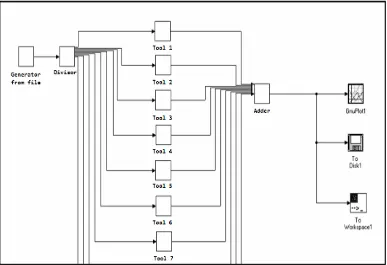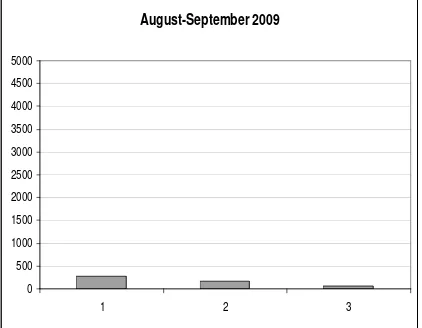Approximation to the Dynamic Hypermedial Device
modeling for the analysis of interactions
Guillermo L. Rodríguez
1and Patricia S. San Martín
11
Centro Internacional Franco Argentino de Ciencias de la Información y de Sistemas, CIFASIS (CONICET-UNR-UPCAM), 27 de febrero 210 bis Blvd,
2000 Rosario, Argentina
guille@fceia.unr.edu.ar; sanmartin@cifasis-conicet.gov.ar
Abstract. The following research proposes a first approximation to the Dynamic Hypermedial Device modeling based on the analysis of interactions. In addition, the DEVS (Discrete EVents dynamic Systems) formalism is employed, which is particularly suitable for the modeling of discrete event systems with continuous time. In this sense, the descriptive model of the denominated “Hypermedial Package” is presented as a basic conceptual component of the DHD. Then, a functional example of basic analysis of the interactions implemented in the PowerDEVS environment is shown. The ultimate goal of this proposal is to provide a tool to assist in the quality analysis and evaluation of the interaction processes through the Information and Communication Technologies (ICT). Moreover, because of the current use of ICT in research, education, and in other fields, they may help in the responsible construction of a more equitable, pluralistic and open “Knowledge Society”.
Key Words: Dynamic Hypermedial Device - Discrete Events - DEVS - Interactions - PowerDEVS - ICT.
1. INTRODUCTION
The quality of the participation processes mediated by the Information and Communication Technologies (ICT), specially when focused on research, education and production, acquire a special relevance in the current “Knowledge Society” on the basis of its responsible construction.
In this sense, we will be dealing with an approximation to the development of a tool that assists in an analytical evaluation of the processes above mentioned, by conceptually introducing the descriptive modeling of what we call Dynamic Hypermedial Device (DHD).
A Dynamic Hypermedial Device is conceptualized as a heterogeneous net [3] consisting of concurrences of technologies and social aspects that make possible for the individuals to act with others in a responsible interaction to investigate, learn, dialogue, confront, build, and evaluate under the physical-virtual modality of the workshop [11], using the communicational, transformational and open potentiality of the hypermedial tools, regulated by a “coordination of contracts” [2].
In this way, DHD is a complex entity composed by the integration of two inseparable dimensions: a technique (or group of constructive techniques that imply a particular configuration and materiality), and a social network given by the intersubjective relations.
The benefits of this work and proposal are based on the frame of two related needs of the research and development. The first one refers to the importance of performing an analysis and evaluation of the implementation of courses and careers in the Virtual Campus services of the Universidad Nacional de Rosario (UNR) [1] since the beginning of 2008. This analysis considers the significance of studying and reflecting upon the qualities of the interactions that appear in the training processes with different media-spreading degrees. Therefore, being able to facilitate the appropriation, building and responsible resignification of the ICT use by the UNR educative community in its practice.
The second issue, which is on an experimental phase, is related to the implementation of an a software piece called “contract”. This tool must be properly placed by the teacher or researchers when designing and implementing the training or research space, in order to promote the dynamic aspect of the interaction processes in the DHD [8]. Following Thomas [10], we know that “the production and social construction processes of the usefulness and functioning of the technologies constitute both sides of the same coin of the socio-technical adaptation.” In reference to the above mentioned requirements, we adopt the use of the DEVS (Discrete EVents dynamic Systems) formalism [12] that puts forward a theory of discrete events in systems with continuous time. Furthermore, it allows a modular description of the phenomena and an approach to the complexity of the system by using a hierarchical approximation.
of future research and perspectives for the complete modeling of the DHD. Also, we mention the impact of developing all the necessary tools under open source license for promoting the cooperative and responsible building of a “Knowledge Society” that is ethically based on the equity and plurality of the access to intellectual common goods.
2. HYPERMEDIAL PACKAGE
Within the interdisciplinary theoretical and methodological frame of complex systems [4], a DHD is built when the Participants (P), through dialogic interactions, can jointly exchange and elaborate knowledge, configure, use and assign new meanings to environments and applications in different types of digital format. In the action, this implies the development of the processes for the knowledge appropriation and dissemination, which account for the possibilities and limitations of the proposed technology mediation. In this sense, the degree of change analysis in the initial contextual situation of the participant, as well as of the DHD technological configurations, is converted into relevant information to evaluate the quality of such processes. Therefore, the DHD basic conceptual component for educate, investigate or produce needs the interaction of at least two individuals by integrating different ICT, the change in the context of one of them [9], and the initial participation of a third one. In this way, the constitution and dynamic determination of a net can be verified and evaluated. We name this contextual situation “Hypermedial Package” (HP) and it is the basic core concept of the systemic function of the DHD. In this HP is where different languages converge (image, sound, verbalizations) and facilitate the interpretation and production on part of the participants. Consequently,
it allows generating interactive and intersubjective dynamic processes that could cause progressive changes of contexts at the level of the individuals as well as of the whole system.
[image:2.595.111.488.535.739.2]Another two important aspects should be observed. The first one is that the evaluation of the contextual change requests a construction of metrics, agreed by among the subjects responsible for the different areas of concern, whether it refers to training or investigation processes. The second aspect refers to the possibility of generating interactive and intersubjective dynamic processes that presently are not fully contemplated in the available technical developments. Thus, our current efforts in research and development seek to implement the “contract” software tool -already mentioned- with the purpose of generate and facilitate a greater dynamism. Within this frame, the main software architecture has a client-server structure that decomposes the processing and storage of the data. The clients request services from other components of the system, and the servers provide services ranging from applications to comprehensive databases. Usually, communication among components is in pairs and it is started by a customer. When a customer requests a service a server respond to it. The configuration and the functionalities of the available tools establish the characteristics (e.g.: use of services) and properties (e.g.: type of interaction) of the HP. For example, the editing service in a Wiki involves a joint construction of a page, while the editing service in a Forum arranges the participants' interventions properly. In this sense, the interpretation and production processes in both tools are shown clearly differentiated by what each activity proposes as participation dynamics and ways of production.
Figure 1 describes, through a UML diagram [7], the key elements and relations that compose a HP. The participants cause certain types of interactions through the use of tools, i.e.: forum, wiki, blog, etc. Those interactions are implemented accordingly to the tools through the services; i.e. basic services may be: create, edit, search, delete, etc. Each tool is presented with a page composed with hyperlinks and multimedia material according to its characteristics. Hyperlinks can lead you to other pages that belong to the same HP or they can direct you to other components of the DHD.
From a modeling point of view, structural specifications and a modular approach constitute a significant simplification, as it is extremely difficult to be able to describe the full behavior of a complex system like DHD. It is more accessible to describe a basic conceptual component behavior such as a HP and then to specify how it interacts with other HPs, forming the net with all its associated elements.
3. DEVS MODEL
In view of the foregoing concepts, it can be affirmed that the fundamental feature of the HP is that the interactions can be considered as events generated by the participants in a continuous time base. This made very suitable the use of DEVS, Discrete EVent System specification [12], due to its significant level of adaptation for modeling complex system, and its efficiency and simplicity in the implementation of
simulations. Therefore, we propose to adapt the usefulness of these methods for DHD, as an analytical and explanatory tool, in terms of contributing to a better configuration and quality of the interaction in physical-virtual spaces.
When analyzing the DHD as a complex system, we can be more explicit about its categorization within the general theory of systems [13].
Regarding the formalism specification the DHD is a system with variables that evolve in a discrete manner with a continuous time base. In addition, about the specification level the DHD is a Category Four system -the highest level of structural knowledge. Knowing the system structure in the DHD allows us to infer their behavior.
In a more thoroughly description, we may make reference to the hierarchical specification of the systems that is based on dynamics and modularity considerations. Considering we are able to know what components the system has and how they fit together, the DHD is on the stage called “Coupled Components”.
Based on the above, we will describe a HP where the interactions of the participants are concretized, integrating both the tools and the services that can configure the DHD.
Generally, an atomic DEVS model is defined by the following structure:
M = (X, Y, S, int, ext, λ, ta)
[image:3.595.90.504.467.715.2]Figure 2 shows us an integrated graphic about the different atomic models that compose a HP.
We will begin by generically describing the tools:
X is the set of values of input events: in general, an event is the representation of a change somewhere in the system. It can be characterized by a value and a moment in which it occurs. In our case, this set would consist of the interactions of the participants according to the HP construction, and it depends on: the ‘ID number’ of the participant, the ‘Tool’ in which the interaction takes place, and the ‘Sevice’ that he or she interacts with.
X = (id., h, s / id. Participants, h Tools: Wiki – Forum – Blog – etc. and s Services: S_Create – S_Edit – S_Search – S_Delete – etc.) Y is the set of values of output events: it will return the interaction degree of the HP to us, being the reflection of the status value. In our case, one of the following values can be obtained:
Y = (1; 2; 3)
S is the set of values of state: it will be determined by the set of values of interactivity of the metric used in the external transition function. In our case:
S = (1; 2; 3)
δext is function of external transition: it will depend on the metric that is linked to the interactive part of the HP. As an example, the first simple metric agreed by consensus may be: if only one participant acts on only a tool, the state value is one. If two participants act, it is two; and if an intervention is generated by a third participant, the given value is three. This participation process constitutes a basic aspect of the constructive possibility of the DHD as a complex system. Going back to what was stated in Section 2, the entire core of meaning can be analyzed when evaluating the HP interaction degree, considering that the verification of a contextual change in at least one of the participants is desirable. An issue also linked to the development of a more comprehensive and integrative metric is still under experimental development within the framework of our research work. Such metric will be directly related to the design of the evaluation instrument, taking into account the purposes of the responsible participant in each case.
The metric, in our example, depends on the Participant's ID number, and on the set of ID numbers of the participants who have interacted in a specific tool. The values of the external transition function that show the interaction level shall be:
ext (id., IDH)
If id. IDH and # IDH = 1, then S = 1 If id. IDH and # IDH = 2, then S = 2 If id. (not ) IDH and # IDH = 3, then S = 3 δint is the function of external transition: in our case, it is not necessary to define it, because the HP level state can only be changed by a participant interaction, which is an external event.
λ is the output function: it will depend on the current value of the system state, i.e. the interactivity degree obtained in the analyzed interaction.
λ= S
Ta is the progress of time, how long the HP will remain in a specific state in the absence of interactions among participants. It is infinite in our case because the system should always wait for an external event that changes its level state.
In addition, the HP will need two more atomic modules. The first one, called divisor, will be in charge of redirecting the events to each particular tool of the HP. And the second one, named adder, will provide us with the total interactivity value of the HP according to the interactivity degree of each tool that belongs to it.
For the divisor:
X (the set of values of input events) is like the vector in the previous case.
Y (the set of values of output events) will be the same vector of events in X, but through the port that corresponds to the requested tool.
S (the set of state values) will correspond to the value of the vector components of the input event.
δext (the function of external transition) will take the input event value and will define the output port from the second component value.
S = (id, h, a) output port = (h)
δint (the function of internal transition) is not necessary.
λ (the output function) will depend on the current value of the system state, redirecting it through the port calculated in the external transition function. Ta (the progress of time) is also infinite in this case. For the adder:
X will be the interactivity degree of the tool used. Y will be the same input event.
S will correspond to the value of interactivity.
δext will take the value of the input event and it will match it to the system state.
S = x
δint is not necessary.
λ will return the state value calculated in the external transition function.
Ta is also infinite.
4. IMPLEMENTATION WITH
POWERDEVS
Figure 3. Implementation in PowerDEVS of the HP.
The second one is a drawing module called
GNUPlot, whose purpose is to graphically show the interactivity degree. The last one, “TO DISK”, saves these interactivity values in a file.
The first module will read the input information data and it will send the resulting component vector every each time event (in our case, since the metric does not require a specific time, it will be a constant value equal to one). The information is formatted as a vector of three components (user ID, requested tool and service).
The second module will take this vector and redirect it to the various tools, depending on the number in the second component (divisor’s atomic model). The third one is the tool that will receive the information (the same full vector). It will provide the interactivity degree of such participation, with the explicit metrics mentioned in section three.
The fourth module will have the task of compiling this information, and presenting it as the total output value of the interactivity level of the HP (adder model).
This interactivity level of the HP is going to be plotted (a synoptic vision) by the fifth module, the GNUPlot graph. Then, it will be saved in a file by the sixth module for later use in the determination of contextual change and the functionality of the “contract” software piece.
In this example, we started with the Activity Log of the MOODLE platform (www.moodle.org), the environment used by the Virtual Campus of the UNR (www.campusvirtualunr.edu.ar).
These entries are exported to a csv file and formatted according to the previously expressed requirements, in order to enable reading them from the PowerDEVS. The file is restructured into a three column table, with the user ID, the number of the selected tool, and the type of requested service for each interaction.
This descriptive model was implemented for the interactive analysis of different courses mediated by the UNR Virtual Campus. These courses were selected with the consent of each teacher. In Figure 4 and 5 we show the interactivity level of each participation over time through the months of August/September and November/December 2009.
[image:5.595.313.523.547.705.2]Figure 5. Degree of HP interactivity November-December.
We analyzed the obtained results that linked each participant interaction with one of the levels of interactivity determined by the metric. In Figure 6 and Figure 7 we can see the global monitoring of the course by showing the total number of interactions divided for each level. Thus, we can observe how the participation mode of the DHD is constructed through the global growing of the interactions (from 505 to 5394). Besides, in the last two months the interaction of level 3 reached an 80%, in contrast to just an 11% in August-September. This illustrates that not only the quantity of interactions increased, but also the quality of them was improved.
It is noteworthy that in the example presented, the teachers proposed specific didactic strategies that promoted responsible participation. Strategies that were based on the theoretical and methodological perspective of the Dynamic Hypermedial Devices (the development of those strategies is beyond the scope of this research).
August-September 2009
0 500 1000 1500 2000 2500 3000 3500 4000 4500 5000
1 2 3
Figure 6. Comparative interactivity degree.
November-December 2009
0 500 1000 1500 2000 2500 3000 3500 4000 4500 5000
[image:6.595.311.523.73.238.2]1 2 3
Figure 7. Comparative interactivity degree.
6. CONCLUSIONS
We have presented an introduction to the problems of the descriptive modeling of the DHD, and the conceptual model of the “Hypermedial Package” as its core component. The implementation of the HP allowed us to analyze and evaluate the interactions of the participants.
These contributions account for a significant progress on basic operational and functional aspects of the use of the DHD, enabling further development and research for an open source tool that would provide quality information about interaction processes.
As a result, the analysis of the interactions gives us more contextual information about the participants, and establishes the necessary conditions for using the “contract” tool –or another one– that would provide more dynamism in the DHD.
Therefore, future developments and research may focus on the elaboration and testing of appropriate metrics that also integrate more elements of the participation. For instance, the design of situational assessments instruments for the classification of the interventions among participants.
[image:6.595.72.283.519.683.2]7. REFERENCES
[1] Campus Virtual Universidad Nacional de Rosario, (http://www.campusvirtualunr.edu.ar).
[2] Dey, A.K.; Salber, D.; Abowd, G.: A Conceptual Framework and a Toolkit for Supporting the Rapid Prototyping of Context-Aware Applications, anchor article of a special issue on Context-Aware Computing. Human-Computer Interaction (HCI) Journal, Vol. 16 (2-4), pp. 97-166. (2001).
[3] Foucault, M.: Saber y verdad. La Piqueta, Madrid (1991).
[4] -Gell-Mann, M.: El quark y el jaguar. Aventuras en lo simple y lo complejo. Tusquets, Barcelona (1995). -García, R.: Sistemas Complejos. Conceptos, método y fundamentación epistemológica de la investigación interdisciplinaria. Buenos Aires: Gedisa, Buenos Aires (2007).
[5] PowerDEVS 2.0 Integrated Tool for Edition and Simulation of Discrete Event Systems. Desarrollado por: Esteban Pagliero, Marcelo Lapadula, Federico Bergero. Dirigido por Ernesto Kofman.
(http://www.fceia.unr.edu.ar/lsd/powerdevs/index.html) [6] Programa Dispositivos Hipermediales Dinámicos (CIFASIS: CONICET-UNR-UPCAM).
(http://www.mesadeareana.edu.ar)
[7] Rumbaugh, J.; Jacobson, I.; Booch, G.: The Unified Modeling Language Reference Manual. Addison Wesley Logman, Inc.; Massachusetts (1999).
[8] San Martín, P.; Sartorio, A.; Guarnieri, G.; Rodríguez, G.: Hacia la construcción de un dispositivo hipermedial dinámico. Educación e investigación para el campo audiovisual interactivo. Universidad Nacional de Quilmes Editorial, Buenos Aires (2008).
[9] Sartorio, A.; Cristiá, M.: Primera aproximación al diseño e implementación de los DHD. XXXIV Congreso Latinoamericano de Informática (2008).
[10] Thomas, H.: “Estructuras cerradas versus procesos dinámicos: trayectorias y estilos de innovación y cambio tecnológicos” en Thomas, H; Buch, A. (compiladores) Actos, actores y artefactos. Universidad Nacional de Quilmes Editorial, Buenos Aires (2008) p. 259.
[11] Vygotsky, L.: El desarrollo de los procesos psicológicos superiores. Grijalbo, Barcelona (1988). [12] Zeigler, B.: Theory of modeling and Simulation. John Wiley & Sons, New York (1976).
[13] Zeigler, B.; King, Tan Gon; Praehofer, H.: Theory of modeling and Simulation. Second edition, Academic Press, New York (2000).



